We often get confused while choosing the right diet for our hedgies. As a result, the poor souls suffer from malnutrition and abnormal growth. Considering the severity, we’ve decided to talk about hedgehog food in detail.
Hedgehogs eat mostly insects and worms, e.g., superworms, earwigs, waxworms, crickets, etc. Their meals also include vegetable fibers to break down the protein. As for treats, you can feed the pets small portions of fruits occasionally. Keepers often add pellets and supplements to the meals to back up mineral requirements.
Keep reading for an insight into the hedgehog diet.
Table of Contents
What Do Hedgehogs Eat?
Hedgehogs are omnivorous, meaning they eat both animal protein and plant matter. However, if you look at their diet chart, it is mostly filled with insects and worms. No wonder why hedgies are tagged as insectivores.
In short, when planning for an ideal hedgehog meal, we must include the following items:
- Protein
- Vegetables
- Fruits
Keepers often add pellets, supplements, and store-bought treats to the list.
Animal Protein for Hedgehogs
In general hedgies need 28% – 35% of protein for normal growth. The protein requirement is 30% – 50% for the African pygmy hedgehogs. According to experts their meals must contain 10% – 20% fat.
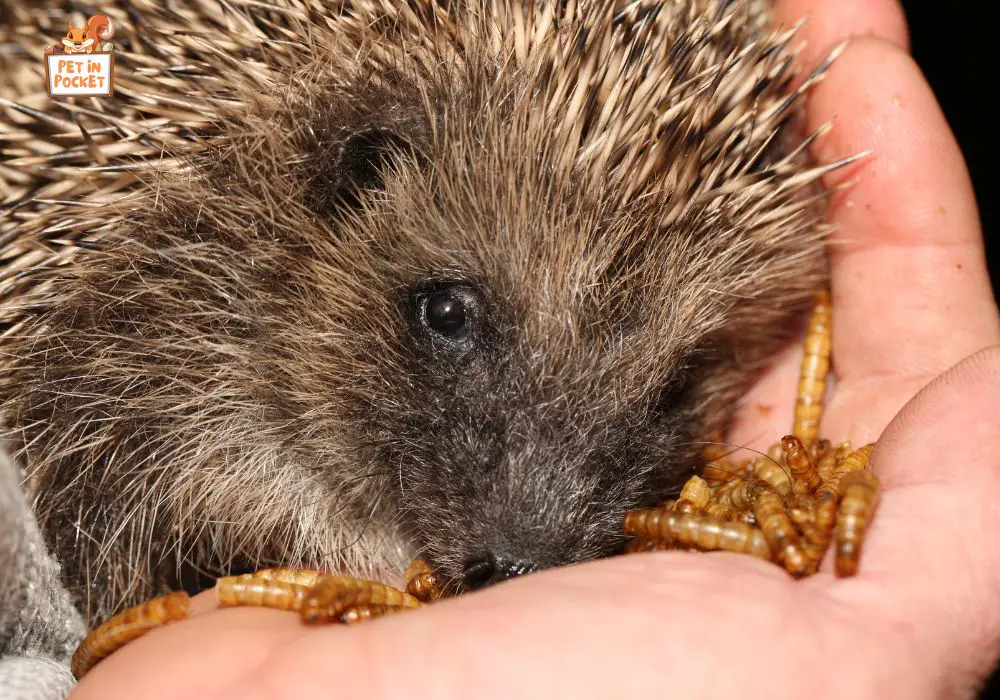
Wild hedgehogs fulfill their protein requirement by hunting small prey and eating worms. Their food list goes as follows:
- Mealworm
- Superworm
- Waxworm
- Calciworm
- Earwigs
- Millipedes
- Earthworm
- Caterpillar
- Pupae
- Dubia roaches
- Leatherjackets
- Black soldier fly
- Grasshopper
- Beetles
- Slugs
- Snails
- Small snake
- Small lizards
- Frogs
- Feeder fish
We also try to replicate the wild food habit as much as possible. Hence, our meal chart for the quill balls mostly consists of whole prey.
However, we understand the struggle to find live insects. Some keepers make the mistake of feeding the hedgehogs wild-caught insects. Remember, captive hedgies are delicate, and the wild prey might make them sick.
We buy live insects and worms from the store regularly. If this sounds like a hassle, switch to dry insects.
Other Protein Sources
We can introduce new protein sources to the hedgie diet occasionally. For example, meat and animal organs can be great additions to their meals. Safe meats for hedgehogs are: chicken, turkey, beef, lamb, and fish. Besides, liver and kidney are also their favorites.
Hedgehogs can not eat raw meat. It raises the risk of bacterial infection. You need to offer them cooked (boiled, roasted, baked) and unseasoned meat. Moreover, these tiny balls can also eat hard-boiled eggs.
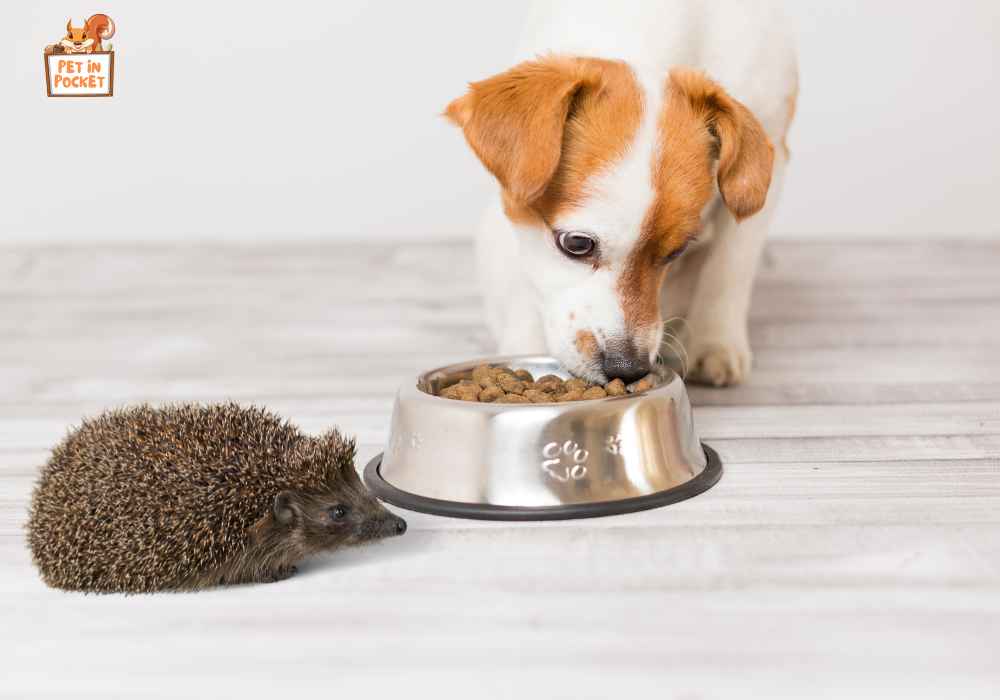
We sometimes add dog and cat meaty food to the hedgehog’s meals. Kibbles that are more than 30% in protein and less than 20% in fat are safe for the hedgies. However, making the pocket pets dependent on cat or dog-based foods is not suggested.
Vegetables for Hedgehogs
Hedgehogs need at least 15% fiber to chunk down the protein. And we all know that vegetables are a rich source of fiber. Safe greens for hedgies are:
- Arugula
- Endive
- Collard green
- Turnip green
- Mustard green
- Dandelion green
- Romaine lettuce
- Tomato
- Green pepper
- Asparagus
- Sweet potato
- Radis
- Peas
- Escarole
- Cucumber
Fruits for Hedgehogs
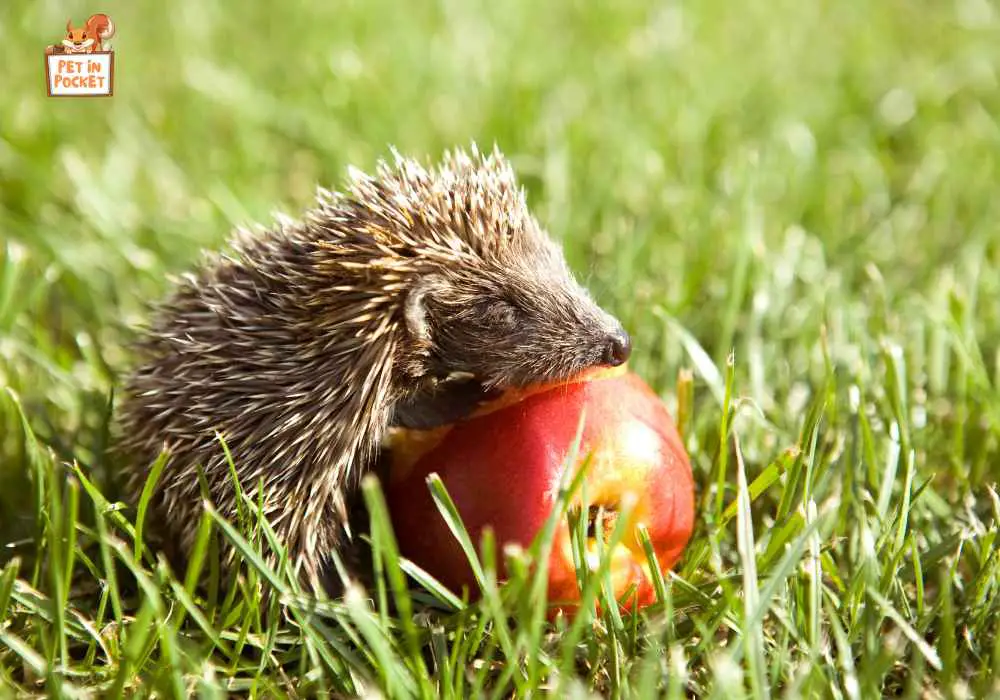
Fruits are not mandatory in a hedgehog diet. The main purpose of fruits is to bring variety to their taste and boost their appetite. Fruits are more like treats for hedgehogs. Safe fruits are:
- Apple
- Banana
- Pumpkin
- Cherry
- Berry
- Watermelon
- Honeydew
- Mango
- Papaya
- Kiwi
Controversial Treats for Hedgehogs
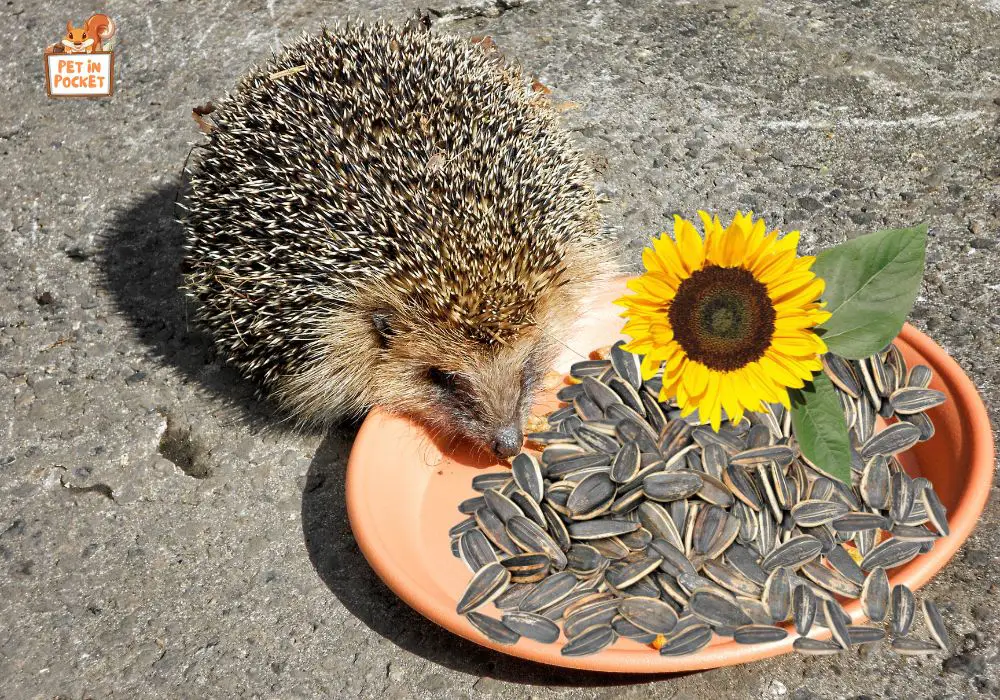
Logically, items with high protein, low fat, and a balanced Ca:P ratio are safe for hedgehogs. However, keepers claim that hedgies can eat fatty and high-phosphorus foods safely as treats. Such controversial treats are,
- Seeds, e.g., sunflower seeds
- Nuts, e.g., peanuts, almonds, etc.
- Cheese
- Rice
- Tofu
See, nuts and seeds are high in phosphorus and fat content. Cheese contains lactose sugar that hedgies can not digest. Likewise, rice and tofu is rich in carbohydrates that can lead to discomfort in the pets.
In short, it is wiser to avoid such controversial treats as much as possible.
Can Hedgehogs Eat Pellets?
In captivity, keepers can not always manage fresh insects and vegetables for the hedgehogs. Pellets can be their saviors in such moments. We buy pellets that are particularly designed for hedgehogs.
However, a pellet-based diet can be highly unhealthy for hedgies. Hence, add pellets to everyday meals in moderation. Our advice is to feed the pets pellets only occasionally to bring variety to the diet.
How Much and How Often to Feed Your Hedgehogs?
Hedgies require 70 to 100 calories per day to maintain a healthy lifestyle. 1 to 3 tablespoons of meals consisting of protein, fiber and treats are enough for them. Generally, fill 1 tablespoon with vegetables and fruits. The rest should contain insects, worms, and kibbles.
We offer our hedgies food twice a day: early morning and early evening. As hedgehogs are nocturnal creatures, they spend the night running and playing.
An early evening snack prepares them for the night activities. On the contrary, an early morning meal helps them regain their energy after playing all night.
As for supplements, it is not necessary if you follow an ideal diet. Otherwise, you can add multivitamins and calcium to their diet once a week.
How to Offer Your Hedgehog Meals?
Follow these tips to make your hedgie’s meals more appealing,
| 1. Add live insects to the meals at least twice or thrice a week. |
| 2. Chop the cooked meat into small pieces and remove any bones beforehand. |
| 3. Wash the vegetables and fruits thoroughly before offering them to the pets. |
| 4. Hedgehogs can not eat the whole vegetables. So, cut them into pieces and boil the veggies to soften the hard texture. |
| 5. Deskin the fruits and slice them into pieces. Do not forget to remove the seeds. |
| 6. Clean the food bowls regularly. |
| 7. Hang multiple bottles in the cage as water sources and clean the tips regularly. |
Foods to Avoid for Hedgehogs
Now that we know what we can offer to our hedgies, let’s look at the forbidden items.
- Avocado
- Iceberg lettuce
- Celery
- Rhubarb leaf
- Spinach
- Raisin
- Garlic
- Onion
- Citrus fruits
- High oxalate and starchy vegetables
- Salty and sweet treats
- Spicy and seasoned foods
- Raw meat
- Raw eggs
- Junk items
- Bakery products
- Dairy items
Special Note:
Potatoes, carrots, and corn are also unhealthy options for hedgehogs. These foods are high in starch. As a result, the quill balls can suffer from constipation or impaction.
Likewise, sweet treats are also harmful for the hedgies. Too much sweets can lead to tooth decay, gum infection, and digestion issues in the pets.
Improper Meals Can Make Hedgies Suffer
Keepers often take the hedgehog meals lightly. They toss the pets anything available at the pantry. Unfortunately, this unhealthy food habit can do permanent damage to your prickle balls. For example:
Obesity
Hedgehogs seem to enjoy high-fat food like seeds, nuts, and mealworms. However, consumption of excessive fatty content leads to fat accumulation under necks and armpits.
Besides, research suggests that sped-up fat metabolism often causes organ damage in the hedgies. An obese hog can not perform its daily activities. Immobility often triggers arthritis, sleeping disorders, and mental anxiety.
Metabolic bone disease
High-oxalate and high phosphorus diet is a common reason for calcium and vitamin D deficiency in hedgehogs. This deficiency soon turns into metabolic bone disease (MBD).
Sick hedgies show symptoms like abnormal growth, splayed legs, broken tooth, bone fracture, limping, etc. Prolonged MBD can develop paralysis in the hedgehogs.
Digestion Issues
Hedgehogs have a sensitive stomach. Diarrhea, constipation, gastrointestinal issues, and abdominal pain are more common in them. Regular fruit and cheese treats can upset their stomach, causing abdominal pain.
Conclusion
Our delicate hedgehogs need a proper balanced diet to thrive. We advise feeding the pets a protein rich meal for healthy growth. Besides, offer the quill balls vegetables and fruits to fulfill mineral requirements.
FAQs
Can hedgehogs eat any human food?
Hedgehogs can eat meat and animal organs. Like us, they can not consume raw meat. So, you must boil, bake, or roast any meat item for the hedgies. However, these tiny hogs can not eat any spice, meaning you should offer them cooked and unseasoned meat only.
Do hedgehogs eat yogurt?
High-fat and sugary yogurts are not safe for hedgehogs. Those raise the risk of obesity and make the pets vulnerable to indigestion. However, you can safely offer the pets low-fat, no-sugar, and non-dairy yogurts as treats.
Can hedgehogs eat honey?
Honey is a natural sweetener. Though natural, the sugar content still can damage our hedgehog’s teeth. Honey on food or honey mixed water can lead to diarrhea, vomiting, and nausea in the pets. We discourage keepers from feeding the hedgies honey in any form.
Do hedgehogs like sugar water?
Hedgehogs can not process sugar like humans. High sugar levels can cause broken teeth and gum infections. Besides, the pets might suffer from diarrhea and abdominal pain. Therefore, avoid sugar water, or juices of any kind. Only freshwater is enough for the hedgehogs.
What to feed a rescued hedgehog?
The rescued hedgie requires warmth more than anything. We would not advise offering them meals the right way. Feeding the hedgehogs wrong meals can cause instant death. Anyway, you can allow the rescued kids to drink water to beat dehydration. Some experts suggest tossing meaty cat/dog food to the hedgehogs as snacks.

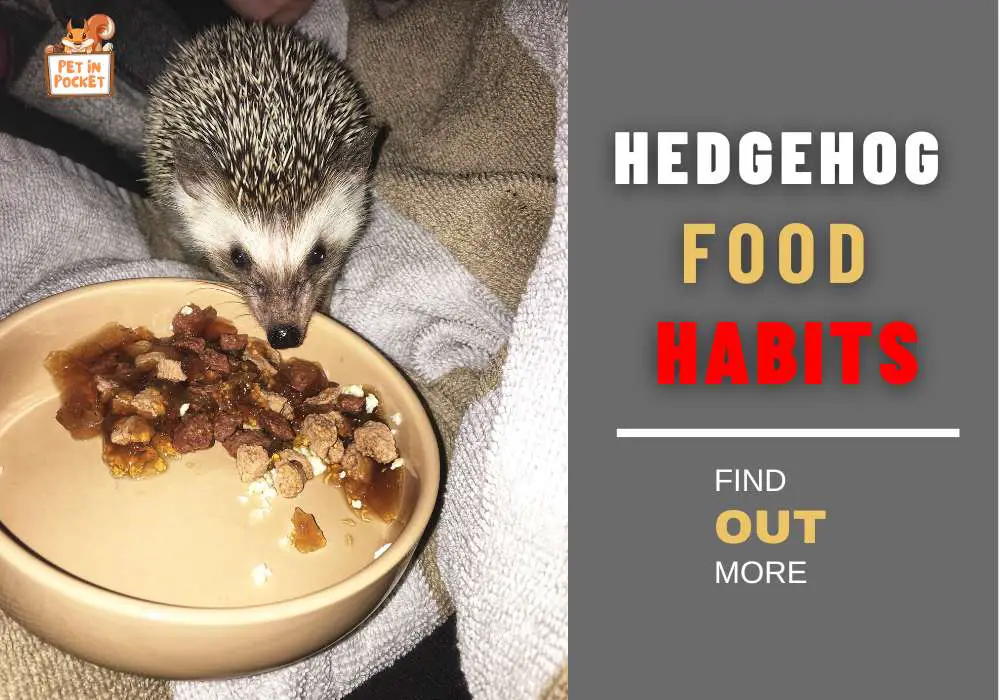



Leave a Reply